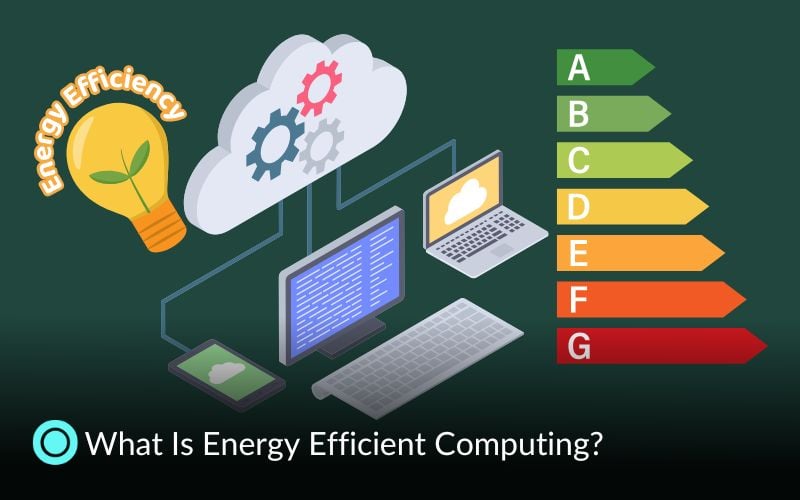Key takeaways
-
Energy-efficient computing reduces power consumption in hardware, software and IT infrastructure to improve performance while minimizing environmental impact.
-
Computing efficiency is about using least energy, processing, memory and bandwidth in a manner that enables efficient work accomplishment.
-
Organizations can introduce green computing through new, high-performance hardware, using efficient cloud providers, shifting workloads to cleaner locations and monitoring emerging.
What does efficiency mean in computing?
Efficiency in general is the ability to produce a desired result with a minimum of waste be it in terms of time, energy or resources. In most industries, efficiency is measured in terms of converting inputs into output effectively. In a business, for example, efficiency is about having high productivity at a low cost. In manufacturing, efficiency is about producing more with less material and less energy.What everyone aims for is getting the most value out of a minimum of waste.
In computing, efficiency happens in a similar manner but in terms of computer systems. Computer efficiency is a matter of both software and hardware in terms of getting work done with less use of resources.
Energy
- The amount of electricity consumed by devices, data centers and networks.
Processing power
- How well a system can get work done with current computer capabilities
Memory and storage
- How well a system stores and retrieves information with no unnecessary strain.
Network bandwidth
- Ability to transmit information at high speed with no bottleneck and lag.
As computing technology keeps getting ever more powerful and widespread, efficiency isn't simply a matter of performance but increasingly a matter of sustainability too.
What is energy efficiency in computing?
Energy efficiency in computers is about reducing computer and software performance in an attempt to consume less power in getting work done.Energy efficiency in computers is closely intertwined with green computing, whose purpose is to make IT infrastructure more environmentally friendly in terms of its footprint.
Key strategies for energy-efficient computing include:
-
Hardware advancements: Including processors with increased efficiency, low-energy memories and low-energy storage technology
-
Software optimization: Reduced processing requirements and efficient workload distribution through algorithms
-
Data center efficiency: Using cooling systems, renewable energy, and virtualization to reduce power consumption.
Companies that adopt energy-efficient computing practices not only cut their power bills but also help decrease the overall carbon emissions around the world, making it a key aspect of sustainable technology advancement.
Why is green computing important to the environment?
The IT sector is a significant source of global use of electricity and greenhouse emissions. All cloud and web searching and streaming consume energy, and most of it comes from nonrenewables.
Green computing assists in reducing such an impact by:
-
Reducing carbon footprint: Computers and servers that are energy efficient reduce consumption of fossil fuels
-
Extending hardware life: Reducing e-waste by developing longer-lasting, repairable, and upgradable devices.
-
Encouraging sustainable behavior: IT companies are adopting circular economy approaches, promoting recycling, and reducing loss of energy.
Green computing isn't simply an environmental necessity but an economic and regulatory necessity for companies wanting to achieve sustainability and efficiency in terms of energy consumption.
What are the goals of green computing?
Sustainability is increasingly becoming a business, social and legislative imperative. As IT creates a significant part of an organisation's footprint, green computing helps in:
-
Minimizing carbon footprint – Computer resource simplification lessens unnecessary consumption and carbon emissions.
-
Lowering energy costs – Efficient hardware and optimized use of resources save operational expenses
-
Meeting compliance requirements – All companies must comply with international environment laws and sector standards.
Key Standards and Regulations:
To support sustainability, organisations have to abide by several international frameworks, such as:
Software Carbon Intensity (SCI) – a software tool for estimating and reducing software-related carbon footprint.
Greenhouse Gas Protocol – an international, widely-used tool for estimating and managing greenhouse gas emissions.
ISO 14001 – a worldwide environment management system standard.
Feature resource:
Information Technology — Software Carbon Intensity (SCI)
What is the greenhouse gas protocol?
What is an example of energy-efficient computing?
Dell's commitment towards environmentally friendly computers can be understood through its in-depth Environmental, Social, and Governance (ESG) reports and several programs. Dell's FY24 ESG Report states that 96.4% of Dell packaging is composed of recycled, renewable, and reduced-carbon-emitting materials. Dell has utilized 375,000 pounds (170,000 kilograms) of ocean-bound plastic in its products too. In terms of efficiency, Dell prioritizes a general green data center strategy that entails optimizing power use, improving techniques for cooling, and collaborating with its partners in an attempt to minimize carbon footprints.
In addition, Dell's modular data center architectures optimize IT performance and reduce infrastructure, power usage, and waste. Dell's architectures aim to optimize energy efficiency and facilitate environmentally responsible operations.These programs represent Dell's dedication to being environmentally responsible in the technology field.
How can you prepare your organization to embrace green computing?
In today's computer era, efficiency in terms of consumption is a critical concern in computing. As technology progresses and computational demand expands, computational efficiency in terms of less consumption and more output is an ever-growing necessity. According to MIT studies, small adjustments in software and hardware can have a significant impact in terms of minimizing consumption and not necessarily at a loss in performance, but actually improving it in most cases.
Such emphasis on efficiency in terms of energy is particularly pertinent for big computer infrastructure, such as cloud platforms and data centres, whose consumption of power is a considerable operational cost. With efficient use of computer processing, organisations can save both environment and expense, and even deliver an overall improvement in system performance. To help companies integrate green computer strategies, Gartner identifies key actions companies can undertake today in becoming efficient in terms of energy consumption:
Short-Term Strategies for Green Computing
✅ Employ Better Measuring Methods – Both software and hardware level monitoring allow organizations to identify inefficiencies and rectify them.
✅ Agreement with Greener Cloud Suppliers – Selecting cloud suppliers that have a robust emphasis on sustainability and renewable energy can make a significant difference in reducing an organisation's footprint.
✅ Shift workloads to cleaner cloud regions – cloud providers have numerous locations, and a number of them utilize cleaner sources of energy. By shifting workloads to such regions, one can reduce emissions.
✅ Run Systems When There's a Lower Emissions of Carbon – Energy sources have a variable intensity and availability at any one point in a day and a week. Running computations at off-peaks can make a contribution towards less burden for the environment.
✅ Retire and Replace In-Build Hardware with More Efficient Newer Systems – In-house hardware is power-hungry and inefficient. Replacing with efficient, newer machines reduces power consumption and extends system life span.
✅ Monitor and Pilot Emerging Technologies – Emerging future technology including neuromorphic processing, processing with light, and quantum processing will save a lot of energy in the future decade. Keeping a track of these emerging trends will allow companies to have a competitive edge when it comes to sustainable processing.
Advance Your Knowledge with iSAQB GREEN Certification
IT practitioners and decision-makers need the right skills to achieve sustainable IT initiatives effectively. One way to extend your expertise and make your organisation harmonise with green computer ethics is through iSAQB GREEN certification. The training scheme takes a systemic approach towards environmentally friendly software engineering and helps organisations build efficient and environmentally friendly IT infrastructure.
By being proactive and educated, companies can reduce their footprint, simplify IT infrastructure and prepare for a future that is increasingly digital and sustainable.
Conclusion
Energy efficient computing is no longer a technological innovation but a necessity for cost savings and responsible stewardship of the environment. With optimized cloud infrastructure, software, and hardware, companies can save considerable amounts of energy with negligible loss in performance. Green computing aids in checking greenhouse emissions, minimizing electronic waste, and putting companies in compliance with global requirements for sustainability.





